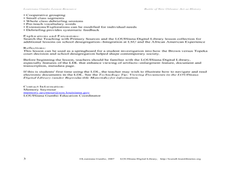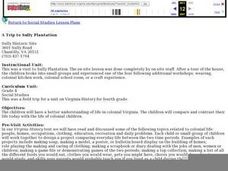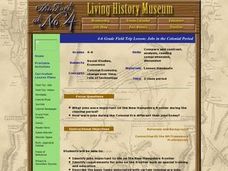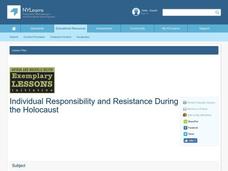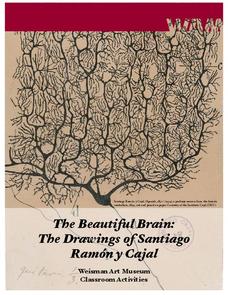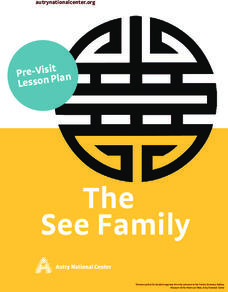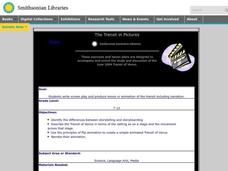Curated OER
Portland Observatory - Images
Students encounter the history and use of a Portland landmark. They explore history, communications, science, and museum visits. Students incorporate how to explore in the Maine Memory Network documents as well. An adventure for any...
Curated OER
Cane River Civil Rights: A Native American Perspective
Students interpret historical evidence presented in primary resources. In this civil rights instructional activity, students examine the civil rights struggle from a Native American perspective. Students analyze documents and write...
Curated OER
A Dinosaur Scavenger Hunt
Students explain what a fossil is, learn six dinosaurs and tell one characteristic about each, then describe verbally what a dinosaur might have looked like.
Curated OER
A Trip to Sully Plantation
Fourth graders have a better understanding of life in colonial Virginia. The students compare and contrast their life today with the life of colonial Students. Each child or small group of students design a project comparing the two time...
Curated OER
Ships to the Sea
Learners examine the development of ship technology and maritime transportation. They define key vocabulary terms, read and discuss handouts, and construct a wooden ship model.
Curated OER
Jobs in the Colonial Period
Pupils identify jobs and their requirements that were important on the New Hampshire frontier. They analyze the importance of certain jobs and compare and contrast them with jobs today. They also examine the role of technology in...
Curated OER
A Date Which Will Live In Infamy
Students use President Franklin D. Roosevelt's radio address following the attack on Pearl Harbor as a primary source to explain American reaction following the attacks. They explain how different Americans reacted to FDR's call for war.
Curated OER
Northwest Coast Indians: Winter Celebrations Potlatch
Upper elementary learners engage in a study about the Potlatch as a Northwest Coast Indians social custom. Groups of pupils plan their own Potlatch ceremony; incorporating activities and creating gifts much like the ones that the Indians...
Curated OER
Individual Responsibility and Resistance During the Holocaust
Students examine what obstacles hinder resistance, what types of resistance are possible and how different individuals resisted Nazi oppression. They examine primary source documents related to the Holocaust and analyze various sources...
John F. Kennedy Presidential Library & Museum
Analyzing the Rhetoric of JFK’s Inaugural Address
“And so, my fellow Americans: ask not what your country can do for you—ask what you can do for your. country.” Did you know that John Kenneth Galbraith, Adlai Stevenson, and Theodore Sorensen helped John F. Kennedy craft his 1961...
Field Museum
The Case of Darwin's Finches
One of the most striking pieces of evidence for Darwin's Evolution of Species was his observations of finches and how their beaks differed from island to island, depending on their primary food sources. So what would happen to the theory...
Curated OER
Northwest Coast Indians: Spring and Summer Salmon
Here is a fabulous lesson about the cultures of the Northwest Indians. Through an exploration of a story about the Salmon People, learners study the practice of harvesting salmon and the cultural importance of salmon to the Northwest...
Curated OER
Tintin and I: Primary and Secondary Sources
Mickey Mouse, Elmo, and Tintin? Belgian cartoonist Georges (Herge) Remi’s famous comic character launches a study of primary and secondary source material and the impact these sources have on storytelling. Class members also examine the...
Curated OER
The Effect of Natural Selection on Genes, Traits and Individuals
Rotating through five stations, evolutionary biologists explore the question of how changes in DNA facilitate the changes in a population over time. High-quality, colorful cards of animals, skeletons, skulls, and DNA sequences can all be...
Curated OER
Hammurabi's Code: What Does It Tell Us About Old Babylonia?
Young scholars examine life in Babylonia during the time of King Hammurabi. They read and discuss excerpts of the Code of Hammurabi, participate in a simulation of advisors to the king, complete an online interactive activity, answer...
Curated OER
Realistic Impressions: Investigating Movements in the Visual Arts
You and your high school class can examine the idea of artistic movements with this lesson. Explore various websites, compare/contrast paintings, after which the assignments are to complete a chart, and write an essay.
Curated OER
Key Ingredients: America by Food
Students participate in a series of activities to explore the types of food Americans eat, how food choices differ in various parts of the country, and how the availability of various foods has changed over time.
University of Minnesota
Beautiful Brain: Brain Inspiration
"Neuroscientists consider Cajal as important to their discipline as Einstein is to physics." The first of four lessons has scholars view Santiago Ramon y Cajal's drawings of neurons. They reflect and respond to the art through writing...
University of Minnesota
Beautiful Brain: Strangest Dream
Do words change or add meaning or interest to a work of art? The final lesson in a four-part series on the beautiful brain as a work of art focuses on art analysis. Scholars write a story about exploring art from the inside. Reflections...
Museum of Tolerance
The Price of Personal Responsibility
A reading of Patrick Henry's "Speech in the Virginia Convention," Henry David Thoreau's "Civil Disobedience," and Rev. Martin Luther King, Jr.'s "Letter from Birmingham Jail" launch a discussion about the price one is willing to pay to...
Curated OER
The See Family
Third graders examine photographs as primary source documents. Students are broken into groups and are given photographs of the See Family.
Curated OER
Masks
Students examine traditional masks from Southwest Indian groups and create their own mask based on Internet research. They share their mask with the members of their class.
John F. Kennedy Presidential Library & Museum
Ask Not What Your Country Can Do for You
Ask not what the lesson here can do for you, but what you can do with the lesson. The answer is quite a lot! Young scholars revisit JFK's famous inaugural address with a focus on his plea for civic engagement. There's a...
Curated OER
The Transit in Pictures
Students investigate the June 2004 Transit of Venus, write a screen play, and produce a movie or animation of the transit including a narration. The difference between storytelling and storyboarding is made clear in this lesson.

